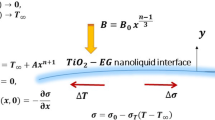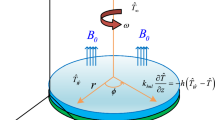Abstract
This article studies the effect of nanoparticle aggregation on the 3D flow of titanium nanoliquid based on ethylene glycol \( ( {\text{C}}_{ 2} {\text{H}}_{ 6} {\text{O}}_{2} - {\text{TiO}}_{2} ) \) due to an exponentially elongated surface. Thermal analysis is carried out considering linear thermal radiation, Joule heating, and mechanisms of the heat source/sink, while the aspect of the homogeneous single-order chemical reaction is included in the analysis of the solute. The variable magnetic field is also accounted. The modified Maxwell model (Maxwell–Bruggeman) is implemented to estimate the effective conductivity of the nanoliquid. The displayed equations are moderated in quantities without dimensions. The 2-point nonlinear boundary value problem (BVP) is solved by the shooting procedure. The importance of effective parameters is described through graphs. Numerical data are presented to study the friction factor, the heat transfer rate, and the mass transfer rate. It has been established that the aggregation of nanoparticles significantly improves the thermal field. Furthermore, the effect of magnetism is more in ordinary fluid than in nanofluid.










Similar content being viewed by others
Abbreviations
- x, y, z :
-
Cartesian coordinate system (m)
- u, v, w :
-
Velocity components along with x, y, and z directions, respectively (m/s)
- \( \mu_{nf} \) :
-
The viscosity of the nanofluid (kg/ms)
- \( \nu_{nf} \) :
-
The kinetic velocity of the nanofluid (m2/s)
- \( \nu_{f} \) :
-
Kinematic viscosity of the base fluid (m2/s)
- \( \left( {\rho c_{p} } \right)_{nf} \) :
-
Specific heat capacitance of the nanofluid (J/kg K)
- \( \left( {\rho c_{p} } \right)_{f} \) :
-
Heat capacity of foundation liquid (J/kg K)
- \( \left( {\rho c_{p} } \right)_{s} \) :
-
Heat capability of solid nanoparticle (J/kg K)
- k nf :
-
Thermal conductivity of the nanofluid (m2/s)
- k f :
-
Thermal conductivity of the base fluid (m2/s)
- k s :
-
Thermal conductivity of the solid nanoparticle (m2/s)
- \( \rho_{nf} \) :
-
The density of nanofluid (kg/m3)
- \( \rho_{f} \) :
-
The density of the base fluid (kg/m3)
- \( \rho_{s} \) :
-
The density of solid nanoparticle (kg/m3)
- Ec:
-
Eckert number
- Pr:
-
Prandtl number
- Kc * :
-
The reaction rate of the solute
- Kc :
-
Chemical reaction parameter
- Q * :
-
Heat source/sink coefficient
- Sc:
-
Schmidt number
- D B :
-
Brownian motion coefficient (m2/s)
- \( \delta \) :
-
Ratio parameter
- Q :
-
Heat source/sink parameter
- A :
-
Temperature exponent
- A * :
-
Concentration exponent
- R :
-
Radiation parameter
- T :
-
Temperature K (°C)
- T w :
-
The variable temperature at the sheet
- \( T_{\infty } \) :
-
Free-stream temperature K (°C)
- C :
-
Concentration
- \( \phi \) :
-
The dimensionless nanoparticle volume fraction
- \( C_{\infty } \) :
-
Free-stream concentration
- C w :
-
Variable concentration at the sheet
- f :
-
Dimensionless velocity
- \( \theta \) :
-
Dimensionless temperature
- \( \varPhi \) :
-
Dimensionless concentration
- C f :
-
The local skin friction coefficient
- Nux :
-
Local Nusselt number
- Shx :
-
Local Sherwood number
References
Choi, S.U.S.: Enhancing Thermal Conductivity of Fluids with Nanoparticles. FED 231/MD 66, pp. 99–105. AMSE, New York (1995)
Buongiorno, J.: Convective transport in nanofluids. J. Heat Transf. 128, 240–250 (2006)
Hamilton, R.L.; Crosser, O.K.: Thermal conductivity of heterogeneous two component systems. IEC Fundam. 1, 187–191 (1962)
Das, S.K.; Choi, S.U.S.: Nanofluids: Science and Technology, p. 124. Wiley, New York (2007)
Lee, S.; Choi, S.U.S.; Li, S.; Eastman, J.A.: Measuring thermal conductivity of fluids containing oxide nanoparticles. J. Heat Transf. 121, 280–289 (1999)
Ghosh, S.; Mukhopadhyay, S.: Stability analysis for model-based study of nanofluid flow over an exponentially shrinking permeable sheet in presence of slip. Neural Comput. Appl. (2019). https://doi.org/10.1007/s00521-019-04221-w
Ghosh, S.; Mukhopadhyay, S.: Viscous flow due to an exponentially shrinking permeable sheet in nanofluid in presence of slip. Int. J. Comput. Methods Eng. Sci. Mech. 18, 309–317 (2017)
Sravan Kumar, T.; Rushi Kumar, B.: A comparative study of thermal radiation effects on MHD flow of nanofluids and heat transfer over a stretching sheet. Front. Heat Mass Transf. 9, 13–19 (2017)
Chen, H.; Ding, Y.; He, Y.; Tan, C.: Rheological behaviour of ethylene glycol based titania nanofluids. Chem. Phys. Lett. 444, 333–337 (2007)
Yu, W.; Xie, H.; Chen, L.; Li, Y.: Investigation of thermal conductivity and viscosity of ethylene glycol based ZnO nanofluid. Thermochimica 491, 92–96 (2009)
Nayak, M.K.; Shaw, S.; Chamkha, A.J.: 3D MHD free convective stretched flow of a radiative nanofluid inspired by variable magnetic field. Arab. J. Sci. Eng. 44, 1269–1282 (2019)
Shah, Z.; Ullah, A.; Bonyah, E.; Ayaz, M.; Islam, S.; Khan, I.: Hall effect on Titania nanofluids thin film flow and radiative thermal behavior with different base fluids on an inclined rotating surface. AIP Adv. (2019). https://doi.org/10.1063/1.5099435
Mebarek-Oudina, F.: Convective heat transfer of Titania nanofluids of different base fluids in cylindrical annulus with discrete heat source. Heat Trans. Asian Res. (2018). https://doi.org/10.1002/htj.21375
Hosseinzadeh, K.; Afsharpanah, F.; Zamani, S.; Gholinia, M.; Ganji, D.D.: A numerical investigation on ethylene glycol-titanium dioxide nanofluid convective flow over a stretching sheet in presence of heat generation/absorption. Case Stud. Therm. Eng. 12, 228–236 (2018)
Siddiqui, A.A.; Sheikholeslami, M.: TiO2-water nanofluid in a porous channel under the effects of an inclined magnetic field and variable thermal conductivity. Appl. Math. Mech. 39, 1201–1216 (2018)
Danish, M.; Yahya, S.M.; Saha, B.B.: Modelling and optimization of thermophysical properties of aqueous titania nanofluid using response surface methodology. J. Therm. Anal. Calorim. (2019). https://doi.org/10.1007/s10973-019-08673-z
Ghadikolaei, S.S.; Hosseinzadeh, K.; Ganji, D.D.: Investigation on ethylene glycol-water mixture fluid suspend by hybrid nanoparticles (TiO2-CuO) over rotating cone with considering nanoparticles shape factor. J. Mol. Liq. (2018). https://doi.org/10.1016/j.molliq.2018.09.084
Waqas, H.; Khan, S.U.; Bhatti, M.M.; Imran, M.: Significance of bioconvection in chemical reactive flow of magnetized Carreau–Yasuda nanofluid with thermal radiation and second-order slip. J. Therm. Anal. Calorim. 2020, 1–14 (2020)
Chamkha, A.J.; Rashad, A.M.; Armaghani, T.; Mansour, M.A.: Effects of partial slip on entropy generation and MHD combined convection in a lid-driven porous enclosure saturated with a Cu–water nanofluid. J. Therm. Anal. Calorim. 132, 1291–1306 (2018)
Shamsabadi, H.; Rashidi, S.; Esfahani, J.A.: Entropy generation analysis for nanofluid flow inside a duct equipped with porous baffles. J. Therm. Anal. Calorim. 135, 1009–1019 (2019)
Seyyedi, S.M.; Dogonchi, A.S.; Ganji, D.D.; Hashemi-Tilehnoee, M.: Entropy generation in a nanofluid-filled semi-annulus cavity by considering the shape of nanoparticles. J. Therm. Anal. Calorim. 138, 1607–1621 (2019)
Khan, A.A.; Marin, M.; Ellahi, R.: Effects of chemical reaction on third-grade MHD fluid flow under the influence of heat and mass transfer with variable reactive index. Heat Transf. Res. 50, 1061–1080 (2019)
Sheikholeslami, M.; Gorji-Bandpy, M.; Ellahi, R.; Zeeshan, A.: Simulation of MHD CuO-water nanofluid flow and convective heat transfer considering Lorentz forces. J. Magn. Magn. Mater. 369, 69–80 (2014)
Wolthers, W.; Duits, M.H.G.; van den Ende, D.; Mellema, J.: Shear history dependence of the viscosity of aggregated colloidal dispersions. J. Rheol. 40, 799–811 (1996)
Benos, L.T.; Karvelas, E.G.; Sarris, I.E.: Crucial effect of aggregations in CNT-water nanofluid magnetohydrodynamic natural convection. Therm. Sci. Eng. Prog. 2019, 263–271 (2019)
Ellahi, R.; Hassan, M.; Zeeshan, A.: Aggregation effects on water base Al2O3-nanofluid over permeable wedge in mixed convection. Asia-Pac. J. Chem. Eng. 11, 179–186 (2016)
Kolsi, L.; Oztop, H.; Ghachem, K.; Almeshaal, M.; Mohammed, H.; Babazadeh, H.; Abu-Hamdeh, N.: Numerical study of periodic magnetic field effect on 3D natural convection of MWCNT-water/nanofluid with consideration of aggregation. Processes 7, 957 (2019)
Kleinstreuer, C.; Feng, Y.: Experimental and theoretical studies of nanofluid thermal conductivity enhancement: a review. Nanoscale Res. Lett. 6, 229 (2011)
Eapen, J.; Rusconi, R.; Piazza, R.; Yip, S.: The classical nature of thermal conduction in nanofluids. J. Heat Transf. 132, 102402-1–102402-14 (2010)
Koo, J.; Kang, Y.; Kleinstreuer, C.: A nonlinear effective thermal conductivity model for carbon nanotube and nanofiber suspensions. Nanotechnology 19, 375705-1–375705-7 (2008)
Bruggeman, D.A.G.: Berechnung verschiedener physikalischer Konstanten von heterogenen Substanzen. Ann. Phys. 24, 636–664 (1935)
Liu, I.-C.; Wang, H.-H.; Peng, Y.-F.: Flow and heat transfer for three-dimensional flow over an exponentially stretching surface. Chem. Eng. Commun. 200, 253–268 (2013)
Acknowledgements
We express our sincere thanks to the editor and anonymous reviewers for their constructive suggestions, and one of the authors (B Mahanthesh) expresses his sincere thanks to the Management, CHRIST (Deemed to be University), Bangalore, India, for their support to complete this research work.
Author information
Authors and Affiliations
Corresponding author
Rights and permissions
About this article
Cite this article
Swain, K., Mahanthesh, B. Thermal Enhancement of Radiating Magneto-Nanoliquid with Nanoparticles Aggregation and Joule Heating: A Three-Dimensional Flow. Arab J Sci Eng 46, 5865–5873 (2021). https://doi.org/10.1007/s13369-020-04979-5
Received:
Accepted:
Published:
Issue Date:
DOI: https://doi.org/10.1007/s13369-020-04979-5




